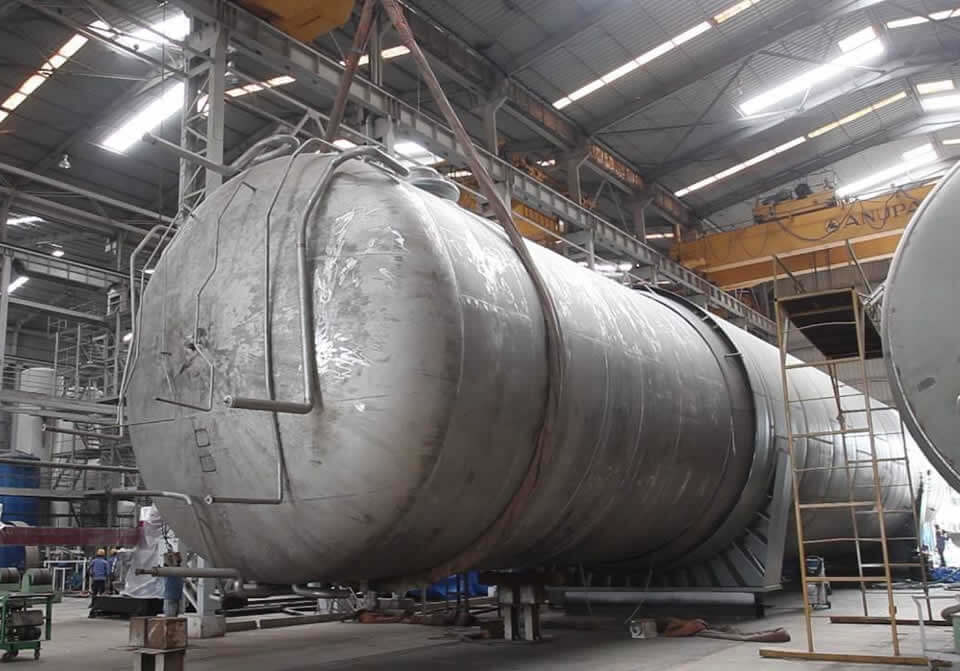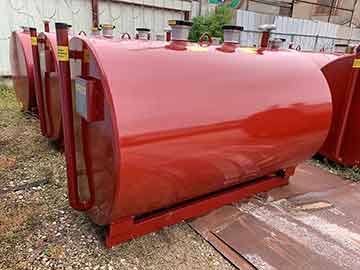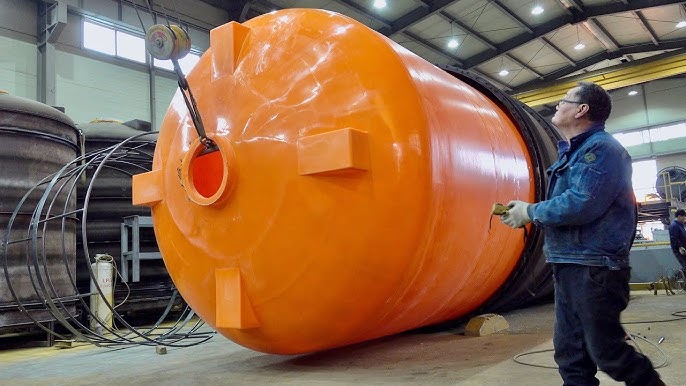The Future of Storage Tank Manufacturing: Fads and Technologies to View
The storage tank manufacturing market gets on the cusp of a critical development, driven by emerging trends in smart materials, automation, and sustainability. As sectors progressively prioritize ecological duty, advancements such as eco-friendly compounds and IoT-driven monitoring systems are improving functional standards. Additionally, the expanding need for personalization and modular designs suggests a shift towards even more adaptable manufacturing practices. Comprehending these trends not just highlights the obstacles in advance yet additionally exposes chances that might redefine the landscape of storage tank production in the coming years. What ramifications might these innovations hold for sector stakeholders?
Developments in Smart Products
Over the last few years, the storage tank manufacturing market has actually observed a substantial uptick in the fostering of smart products, changing design and performance. Smart products, which can react dynamically to environmental changes, have allowed manufacturers to produce storage tanks that are not only extra sturdy yet likewise a lot more reliable in their operational capabilities.
One remarkable innovation is the assimilation of shape memory alloys and polymers that can adapt to varying stress and temperatures. This flexibility enhances the structural stability of storage tanks, decreasing the threat of failures and leakages (Texas Oil & Gas Storage Tank Fabrication Authority). Additionally, these products frequently show self-healing residential properties, which better prolongs the life-span of storage space tanks, lessening upkeep prices and enhancing safety and security
The incorporation of sensors within smart products permits for real-time monitoring of container conditions, giving important data that aids in predictive maintenance and risk monitoring. This data-driven technique not just enhances operational effectiveness yet likewise aligns with environmental sustainability objectives by maximizing source usage and protecting against spills.
Surge of Automation Technologies
The increase of automation innovations is changing storage tank production by integrating robotics into production procedures, improving efficiency and precision. Additionally, the release of clever sensing units allows real-time surveillance, making certain high quality control and security requirements are satisfied. AI-driven process optimization even more improves procedures, decreasing expenses and improving general efficiency in the market.
Robotics Combination in Manufacturing
Robotics assimilation is revolutionizing the production landscape, particularly in the storage tank market. As manufacturers venture for increased efficiency and accuracy, robotics innovations are ending up being important devices for enhancing manufacturing processes. Automated systems can performing repeated tasks with higher speed and precision than human labor, decreasing the likelihood of mistakes and improving general product top quality.
One of the essential advantages of robot combination is the capacity to optimize workflows. Automated robot arms can deal with hefty products, weld parts, and perform examinations, which reduces physical strain on workers and reduces downtime. This change not only enhances security but additionally allows human workers to concentrate on even more facility and value-added tasks.
Robotics can facilitate adaptable production, enabling business to adapt rapidly to transforming market needs. Advanced programs enables robotics to conveniently change in between various jobs and items, which is particularly helpful in a market where customization is progressively desired
As robotics innovation proceeds to progress, manufacturers can anticipate improved abilities, including improved device discovering algorithms and enhanced fact applications, further driving effectiveness in storage tank production and setting brand-new requirements for the industry.
Smart Sensors Deployment

Moreover, the data gathered from these sensors can be leveraged to maximize the supply chain, guaranteeing that products are readily available when needed while reducing waste. This level of insight enables manufacturers to react quickly to transforming conditions and consumer needs, boosting total performance.
Furthermore, wise sensors contribute to enhanced regulatory conformity by constantly monitoring environmental factors and making sure adherence to safety criteria. As the sector proceeds towards more lasting techniques, the capability to monitor emissions and resource intake in real-time is vital.
AI-Driven Process Optimization
Manufacturers in the storage tank industry are significantly utilizing the power of AI-driven procedure optimization to boost functional effectiveness and decision-making abilities. By incorporating advanced algorithms and device discovering techniques, business can examine vast quantities of information generated throughout the production process. This data-driven technique makes it possible for real-time surveillance of production metrics, leading to more timely interventions and educated decisions.
AI technologies facilitate anticipating upkeep, enabling manufacturers to prepare for devices failings prior to they happen, therefore lowering downtime and maintenance prices. Additionally, these systems can enhance source appropriation by examining manufacturing patterns and changing process, making certain that products and labor are utilized effectively.
AI-driven optimization boosts high quality control by determining prospective flaws throughout the manufacturing procedure. Automated assessments powered by AI can rapidly detect disparities, ensuring that just items meeting rigid top quality standards advance through the assembly line.
As the storage tank sector remains to welcome automation, AI-driven process optimization sticks out as a transformative force, driving development and competitiveness. By leveraging these modern technologies, manufacturers can not only improve operations however likewise adapt promptly to market demands, placing themselves for sustainable development in a progressively intricate production landscape.
Focus on Sustainability Practices
As the storage tank manufacturing industry develops, a significant focus is positioned on sustainability techniques. This consists of the fostering of green materials, the implementation of energy-efficient production processes, and the integration of circular economy concepts. By prioritizing these initiatives, manufacturers not just reduce their environmental impact however also improve the long life and performance of their products.
Environment-friendly Products Adoption
Increasingly, the storage tank production industry is welcoming eco-friendly products as a fundamental facet of sustainability practices. This change is driven by enhanced ecological understanding and regulative stress, triggering manufacturers to look for choices that lessen eco-friendly influence.
Recycled steels and naturally degradable composites are getting grip, supplying both performance and reduced carbon impacts. Using high-recycled-content steel not only minimizes the need for virgin materials yet likewise enhances the overall sustainability of the item lifecycle. In addition, manufacturers are exploring bio-based resins that supply toughness while being less unsafe to the setting.
The fostering of environmentally friendly finishes and finishes, which are totally free from unpredictable natural compounds (VOCs), reflects the industry's commitment to minimizing air pollution and advertising much healthier working conditions. These advancements not just line up with global sustainability objectives however also fulfill the growing market demand for greener products.
The assimilation of eco-friendly materials in storage tank manufacturing is not simply a trend; it represents find this a positive technique towards accountable manufacturing that prioritizes both ecological stewardship and economic viability, setting a brand-new requirement for future developments in the market.
Energy-efficient Manufacturing Processes
There is an expanding acknowledgment within the storage tank manufacturing market of the significance of energy-efficient processes as an essential component of sustainable methods. As the industry faces boosting stress to lower its carbon footprint, manufacturers are carrying out ingenious modern technologies and methods focused on decreasing energy intake throughout the production cycle.
One considerable trend is the fostering of sophisticated manufacturing techniques such as lean manufacturing and automation. These methods simplify procedures, decrease waste, and enhance productivity, while likewise lowering energy use. Additionally, the combination of renewable resource resources, such as solar and wind power, right into manufacturing facilities is coming to be a lot more prevalent, allowing business to operate sustainably and decrease dependence on fossil gas.
Energy-efficient machinery and tools are being focused on in new financial investments, as manufacturers seek to optimize their power usage. Using energy management systems allows real-time monitoring and evaluation, promoting constant enhancement in power performance.
Round Economy Integration
A notable shift towards round economic climate assimilation is transforming sustainability techniques within the storage tank manufacturing market. This strategy stresses the value of resource efficiency, waste reduction, and the recycling of products throughout the manufacturing lifecycle. By taking on circular principles, manufacturers are significantly concentrated on designing containers that focus on repairability, long life, and recyclability.
As part of this adjustment, firms are discovering innovative products and production approaches that decrease environmental influence. The consolidation of recycled steels and plastics not only decreases the demand for virgin sources yet additionally reduces carbon emissions connected with removal and processing. Furthermore, manufacturers are implementing take-back systems that promote the repair and recycling of end-of-life tanks, therefore shutting the loophole in the production cycle.
Cooperation among stakeholders, consisting of vendors and consumers, is crucial for cultivating a circular economic situation (Oil & Gas Storage Tank Fabrication). This partnership makes it possible for the sharing of ideal techniques and motivates the advancement of lasting supply chains. Ultimately, integrating round economy principles into storage tank production not just improves environmental stewardship yet likewise placements business to meet developing regulative criteria and consumer assumptions for sustainability
Boosted Security Procedures
In today's manufacturing landscape, enhanced safety procedures have become important for storage tank manufacturers. The market deals with enhancing regulatory scrutiny and demands for greater safety and security standards because of the potential risks connected with the storage of hazardous products. Manufacturers are embracing a diverse approach to improve security measures throughout the production procedure.
One substantial development is the execution of innovative threat evaluation tools that identify prospective hazards during the layout and production stages. These tools promote aggressive procedures to alleviate dangers before they escalate into critical concerns. Manufacturers are spending in employee training programs that emphasize safety techniques, guaranteeing that all workers are fluent in emergency treatments and tools handling.
Furthermore, there is an expanding focus on using high-quality materials and ingenious layouts that improve architectural integrity and minimize the chance of leakages or failings. Routine upkeep checks and strenuous screening procedures are likewise being incorporated into the manufacturing lifecycle to ensure compliance with safety and security regulations.
Combination of IoT Solutions

Furthermore, IoT devices help with anticipating upkeep, which decreases downtime and prolongs the lifespan of tank. By analyzing data accumulated from sensing units, manufacturers can predict potential failures and execute upkeep activities prior to critical concerns emerge. This aggressive strategy not only conserves prices but also ensures conformity with safety and security laws.
Furthermore, IoT assimilation sustains far better inventory monitoring by providing precise, real-time information on saved products. Texas Oil & Gas Storage Tank Fabrication Authority. This capability assists manufacturers optimize their supply chains, guaranteeing that necessary resources are readily available when required, therefore improving general productivity
The implementation of IoT options allows boosted interaction between containers and centralized management systems, enhancing procedures. As the storage tank manufacturing market proceeds to take on IoT innovations, we can expect significant developments in safety methods and operational effectiveness, ultimately resulting in more resilient manufacturing methods.
Customization and Modular Style
Versatility in design has actually come to be a cornerstone of contemporary storage tank production as customization and modular design alternatives gain grip. The advancing needs of sectors such as oil and gas, chemicals, and water monitoring demand tailored services that accommodate particular functional needs. Modification allows manufacturers to create tanks that meet distinct specs regarding dimension, form, product, and performance, ensuring peak efficiency and efficiency.
Modular layout, on the other hand, permits for the setting up of pre-fabricated parts, causing significant time and cost savings. This method helps with quick release and scalability, making it possible for services to adjust their storage abilities in reaction to varying demand. Furthermore, modular systems can be conveniently expanded or reconfigured, decreasing downtime and improving functional versatility.
The integration of sophisticated manufacturing technologies, such as 3D printing and computer-aided style (CAD), additional enhances personalization opportunities. These developments allow precise engineering and quick prototyping, enabling for fast adjustments and iterations during the layout procedure.

Regulative Modifications and Conformity
Regulatory modifications and conformity requirements often form the landscape of storage tank production, compelling manufacturers to remain vigilant and adaptable. With boosting ecological problems and the push for sustainable techniques, regulative bodies are implementing stricter guidelines worrying discharges, products, and security standards. For example, the united state Environmental Defense Firm (EPA) and different state firms are revising guidelines that regulate the design and installment of tank, particularly those made use of for hazardous materials.
Manufacturers need to not just abide by existing guidelines however additionally anticipate future adjustments, demanding continuous investment in research and development. This consists of taking on cutting-edge materials and modern technologies that enhance storage tank stability and environmental management. Furthermore, conformity with laws such as the Spill Prevention, Control, and Countermeasure (SPCC) guideline is necessary for manufacturers to avoid legal liabilities and substantial penalties.
Additionally, the assimilation of digital innovations assists in compliance monitoring and coverage, making it possible for manufacturers to preserve openness and efficiency. As regulations proceed to progress, staying educated and positive is crucial for storage tank manufacturers to ensure conformity, safeguard public wellness, and safeguard the atmosphere, inevitably shaping an extra sustainable sector.
Often Asked Inquiries

What Are the Many Typical Products Utilized in Storage Tank Manufacturing?
The most common materials used in storage tank manufacturing include carbon steel, stainless-steel, and fiberglass. Each product offers unique advantages, such as sturdiness, deterioration resistance, and adaptability to different storage space requirements and ecological conditions.
How Do Tank Impact Local Ecosystems Throughout Setup?
Tank installation can disrupt regional ecological communities by altering land usage, influencing water drainage patterns, and possibly introducing contaminants. Proper website evaluations and ecological management practices are essential to alleviate these impacts and secure biodiversity.
What Is the Ordinary Life-span of a Modern Storage Tank?
The average life-span of a contemporary storage tank commonly varies from 20 to three decades. Variables such as material high quality, ecological problems, and maintenance techniques considerably affect long life and total efficiency throughout their operational life expectancy.
Exactly How Do Manufacturers Make Sure High Quality Control in Production?
Manufacturers ensure top quality control via strenuous testing procedures, adherence to sector requirements, and continual surveillance throughout production (Storage Tank Manufacturing). Advanced modern technologies such as automation and real-time data analysis even more improve uniformity and dependability in storage tank manufacturing procedures
What Are the Costs Connected With Maintaining Tank?
Maintaining storage containers includes various costs, consisting of routine examinations, repairs, regulatory conformity, rust prevention, and prospective ecological remediation. These expenditures can substantially impact total functional budgets and require positive monitoring to guarantee lasting effectiveness and safety and security.
As manufacturers progressively embrace automation modern technologies, the release of clever sensors is becoming a critical facet of contemporary production procedures in the storage container sector. Manufacturers in the storage space tank sector are significantly using the power of AI-driven process optimization to boost operational performance and decision-making capabilities. Progressively, the storage tank production industry is welcoming eco-friendly materials as a fundamental element of sustainability methods. In today's production landscape, boosted safety procedures have actually come to be imperative for storage tank manufacturers. Regulatory changes and compliance demands regularly form the landscape of storage space tank manufacturing, compelling manufacturers to stay vigilant and versatile.